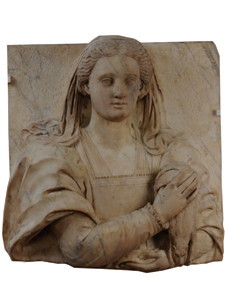Lady of the Ermine (Hall 18)

This noble lady, dressed in Renaissance clothing, holds an ermine in her hands. This symbol of purity and uprightness has led to the work's current name. The woman's face (classically beautiful) and hairstyle (a veiled coiffure) recall Italian works from around 1500.
This work came from the family home in Barcelona of Miquel Mai, ambassador and vice-chancellor under Carlos V. The building later passed into the hands of the Marquises of Barberá; it was destroyed and abandoned just before 1800. This relief was saved along with several other pieces, which were taken to the Solterra Barberá palace, also located in Barcelona. There, the Lady of the Ermine presided over the stairway leading to the main floor. The history of the relief is well-documented from the 18th century and is identified as Priscila. It was the Marquis of Barberá himself who donated it to Frederic Marès in 1962.
The fact that it is sculpted out of marble, as well as its marked Italianate style, lead us to believe that this work may have been imported from Italy. Such is also the case with the other round bas-reliefs that once decorated the courtyard of the vice-chancellor's palace. The Museum has conserved one of these rondels with a feminine bust, which is on view in this gallery.


